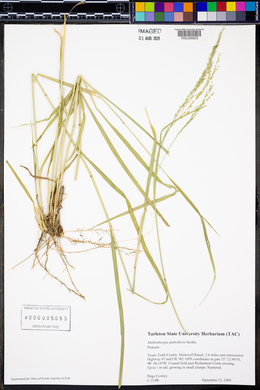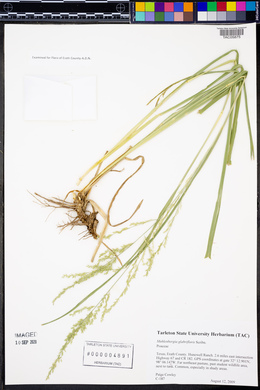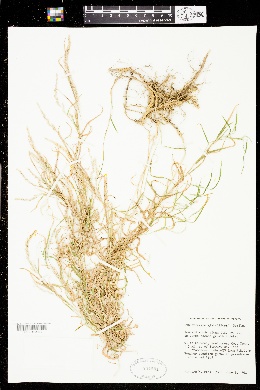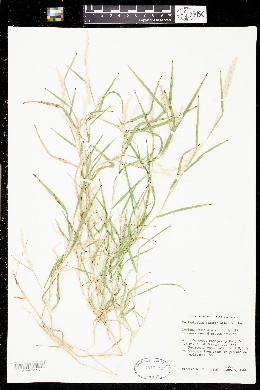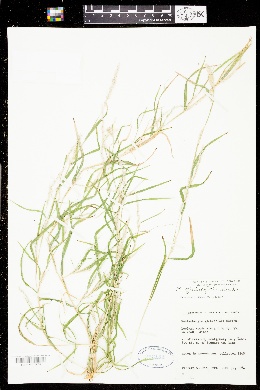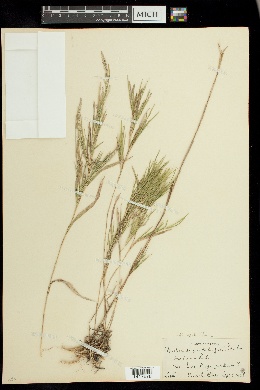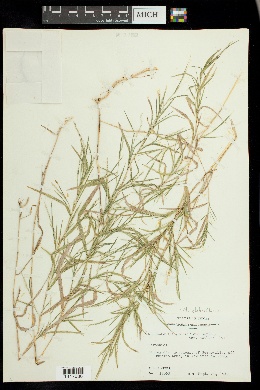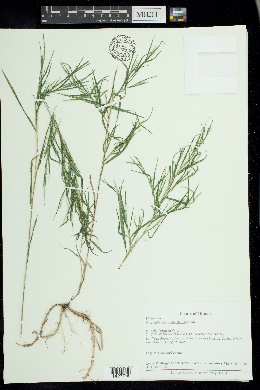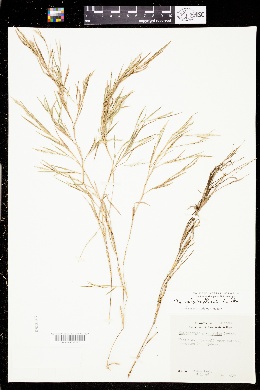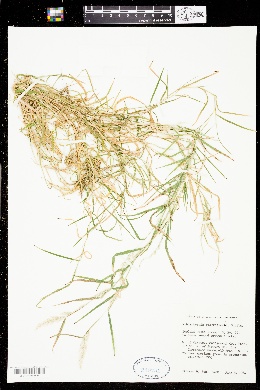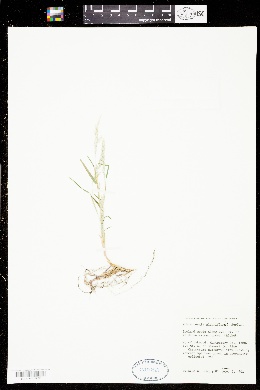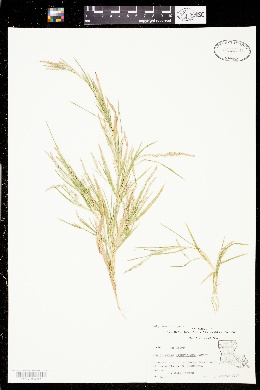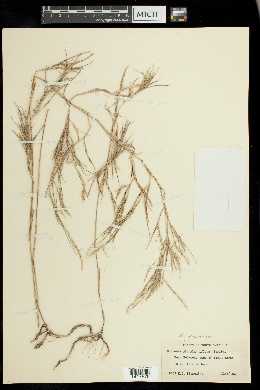Muhlenbergia glabrifloris
|
|
|
|
Family: Poaceae
Smooth Muhly, more...Inland Muhly
|
Plants perennial; rhizomatous, not cespitose. Culms 30-100 cm tall, 0.5-2 mm thick, herbaceous, ascending or decumbent, bushy and much branched above; internodes smooth and shiny for most of their length, scabridulous or strigulose below the nodes. Sheaths glabrous, margins hyaline; ligules 0.5-1.5 mm, membranous, truncate, lacerate-ciliolate; blades 3-8 cm long, (1.5)2-4 mm wide, flat, glabrous. Panicles 2-6.5 cm long, 0.2-0.8 cm wide, lobed, dense; branches 0.3-2.5 cm, ascending, closely appressed; axillary panicles common, partly included in or exserted from the subtending sheaths; pedicels 0.3-2.2 mm, scabrous to strigulose. Spikelets 2.2-3.5 mm. Glumes subequal, 1.5-3.5 mm, from 3/4 as long as to longer than the lemmas, smooth or scabridulous near the apices, 1-veined; upper glumes acuminate, acute, unawned or awned, awns to 1.2 mm; lemmas 2.2-3.1 mm, narrowly lanceolate, shiny, stramineous or purplish, usually completely glabrous (rarely with a few appressed hairs), apices scabridulous, acuminate, unawned; paleas 2.2-3.1 mm, narrowly lanceolate; anthers 0.3-0.5 mm, yellow to purplish. Caryopses 1.2-1.4 mm, fusiform, brown. 2n = 40. Muhlenbergia glabrifloris grows at the edge of dry forests, in prairies, thickets, and along roadsides in pine and oak associations, at elevations of 20-400 m. It is restricted to the southern portion of the central contiguous United States. It resembles M. frondosa, but differs from that species in its glabrous lemmas and shorter caryopses (1.2-1.4 mm rather than 1.6-1.9 mm). Perennial rhizome-forming herb 30 cm - 1.07 m tall Leaves: having open, hairless sheaths with transparent margins and ligules that are 0.5 - 1.5 mm long, membranous, flat-topped, and unevenly cut to hairy along the margins. The blades are 3 - 8 cm long, 1.5 - 4 mm wide, flat, and hairless. Inflorescence: terminal, spike-like and branched (panicle), dense, 2 - 6.5 cm long, 0.2 - 0.8 cm wide, with axillary inflorescences partly surrounded by or exserted above the leaf sheaths. The ascending branches are 0.3 - 2.5 cm long and closely appressed. Fruit: a brown, spindle-shaped caryopsis, 1.2 - 1.4 mm long. Culm: 30 cm - 1 m long, ascending to decumbent, highly branched above, 0.5 - 2 mm wide, the internodes minutely rough or appressed hairy just beneath the nodes but smooth and shiny elsewhere. Spikelets: 2.2 - 3.5 mm long, borne on a stalk 0.3 - 2.2 mm long. Glumes: nearly equal, 1.5 - 3.5 mm long, single-veined, smooth or minutely rough near the tip. The upper glume is pointed or has an awn to 1.2 mm long at the tip. Florets: with yellow to purplish anthers 0.3 - 0.5 mm long. Lemma: shiny tan to purplish, 2.2 - 3.1 mm long, narrow lance-shaped with a minutely rough pointed tip, awnless, three-veined, and usually hairless. Palea: 2.2 - 3.1 mm long, narrow lance-shaped, two-veined. Similar species: The following species also have shiny, mostly hairless culms. The glumes of Muhlenbergia schreberi are missing or minute, and those of Muhlenbergia x curtisetosa are unequal and sometimes awned. Muhlenbergia sobolifera is identified by its egg-shaped, sometimes awned glumes and erect to ascending culms that rarely branch. Muhlenbergia racemosa has awned, narrow, 3 - 8 mm long glumes that are much longer than the lemmas and end in a minutely rough awn. The narrow, 1.4 - 2 mm long, sometimes awned glumes of Muhlenbergia bushii are shorter than the lemmas, and the ligules are 0.2 - 0.6 mm long. Muhlenbergia frondosa has narrow, 2 - 4 mm long, sometimes awned glumes that are shorter than to slightly longer than the lemmas, and the ligules are 0.7 - 1.7 mm long. Flowering: July to October Habitat and ecology: Moist woods. Occurence in the Chicago region: native Etymology: Muhlenbergia is named after American botanist, Gotthilf Henry Ernest Muhlenberg (1753-1815). Glabrifloris means smooth-flowered. Author: The Morton Arboretum Vigorously rhizomatous, 3-10 dm, becoming much branched and very leafy; internodes slightly puberulent near the top, otherwise glabrous; blades and sheaths glabrous; blades stiffish, 3-5(-8) cm נ1.5-4 mm; ligule 0.5-1.5 mm; infls numerous, terminal and axillary, dense, lobulate, cylindric, 2-5 cm נ3-5 mm, included at base or on peduncles exsert 1-4 cm; spikelets densely crowded, often subsessile; glumes slightly shorter to slightly longer than the lemma, this 2.2-3 mm, glabrous, awnless; anthers 0.3-0.5 mm; 2n=40. Mostly in shade on low ground in heavy clay; irregularly from Va. and N.C. to Io., Mo., Ala., and Tex.; rare. Gleason, Henry A. & Cronquist, Arthur J. 1991. Manual of vascular plants of northeastern United States and adjacent Canada. lxxv + 910 pp. ©The New York Botanical Garden. All rights reserved. Used by permission. From Flora of Indiana (1940) by Charles C. Deam This species, as now known, is restricted to seven of our southwestern counties. It is found in hard, white clay soil in moist or wet places, usually in pin oak woods or in the pin oak and post oak flats of the southwestern part of Posey County. Probably locally frequent and possibly well distributed in the southwestern counties where its habitat is found. …… Indiana Coefficient of Conservatism: C = 8 Wetland Indicator Status: FACU |















